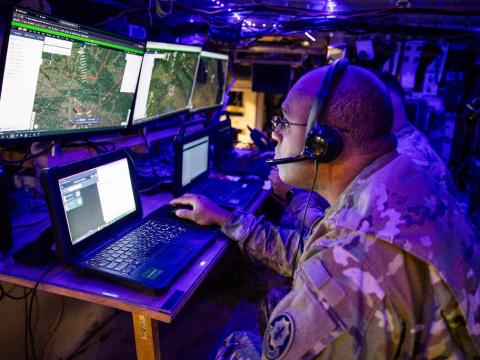U.S. Army Poised for 30-Month NGC2 Sprint
What was initially forecast to take four to five years has been challenged to a 30-month sprint by the U.S. Army’s chief of staff to implement the Next Generation Command and Control (NGC2) acceleration plan. On October 1, the Army is set to embark on a journey to replace the transport and infrastructure layers on the tactical side of the environment. By the fourth quarter of 2026, the kit will be in the hands of Army formations, “and thus, the 30-month sprint begins,” Lt. Gen. Jeth Rey said.
Rey assumed his duties as the U.S. Army deputy chief of staff, G-6, at the beginning of the year, in which he serves as the principal military adviser to the chief of staff of the Army and the chief information officer.
“We’re going to need your help,” he told industry during his closing keynote at TechNet Augusta 2025, in Augusta, Georgia. “Information will be out on the road soon on the things we’re going to be buying.”
During his address, Rey pointed to a whiteboard that displayed the breakdown of the Army’s six computing environments split into three sections: enterprise; command post, mounted, dismounted; and sensors and real-time safety critical.
Command post, mounted and dismounted were all written in the center section. The Army, Rey explained, is now working on replacing the three computing environments, which are comprised of 13 C2 systems, with NGC2.
“What [Brig. Gen. Michael] Kaloostian and his team [are] working toward is moving all that into this ecosystem for [application programming interfaces] so we could ingest intel data, sustainment data, fires data, all inside this ecosystem that has large language models, AI [artificial intelligence] and machine learning to get after it,” Rey explained.
To meet this challenge, Kaloostian’s office identified four areas of focus: transport, infrastructure, integrated data and application.
“We just got all the units lined up under the ReARMM [Regionally Aligned Readiness and Modernization Model],” Rey continued, noting that all are ready for the 30-month sprint to take on the transport and infrastructure layers.
“On top of that, Gen. Kaloostian and his team are working diligently on integrated data and application layers,” he added, referencing also Joseph Welch’s earlier remarks on revolutionizing the NGC2 contracting process.
“It’s about how we exchange information within that integrated data … how do those applications work together in that ecosystem using large language models and using machine learning and AI in order to aggregate that data and display it on a [common operational picture] to make an informed decision,” Rey offered.
Over time, the deputy chief of staff suggested, the six computing environments will transform into only two: operational technology and information technology. With that comes an added challenge of data overload, however.
“Our commanders are still telling us that they’re overwhelmed by the amount of data coming in on the battlefield,” Rey explained. This is where emerging technologies and tools such as AI will come into play, he said.
Rey went on to speak about the rooftop atop the discussed operational picture, which is the Army Unified Network Plan 2.0, which he said largely highlights the criticality of data-centricity and zero trust.
Following its first iteration published in 2021, the Army released its Unified Network Plan 2.0 (AUNP 2.0), in March of this year.
The newly published plan is primarily focused on phase two, which explores operationalizing the unified network in the near term (2024-2026). AUNP 2.0 also partly covers phase three to look at 2027 and beyond for continuous modernization and transformation of the unified network.
“We are committed to reducing barriers and increasing transparency on everything that we do going forward,” Rey said, emphasizing an increased focus on agile funding.
We are committed to reducing barriers and increasing transparency on everything that we do going forward.
Rey also stressed the need for more rapid technology deployment to the warfighters. Additionally, he said, built-in cyber protection and resiliency are a must. “Every line of code, every piece of hardware must be evaluated to ensure protection … intellectual property has to be protected.”
He also reminded the audience of the Army’s continued use of MOSA, a modular open systems approach.
“Soldiers must be able to fix what breaks and upgrade what’s out there,” he noted.
Rey concluded his address with a call to action to all leaders and innovators in the room.
“I need you to invest in your teams, train as you fight and always encourage innovation,” he said. “Our goal is to have soldiers that are ready to win anytime, anywhere. This means giving them the data they need to make an informed decision faster than our adversaries. Our success [and] their lives depend on what we’re doing each and every day.
“We can’t fail.”
George I. Seffers contributed to this report.
TechNet Augusta is organized by AFCEA International with help from the U.S. Army Cyber Center of Excellence. SIGNAL Media is the official media of AFCEA International.



Comments